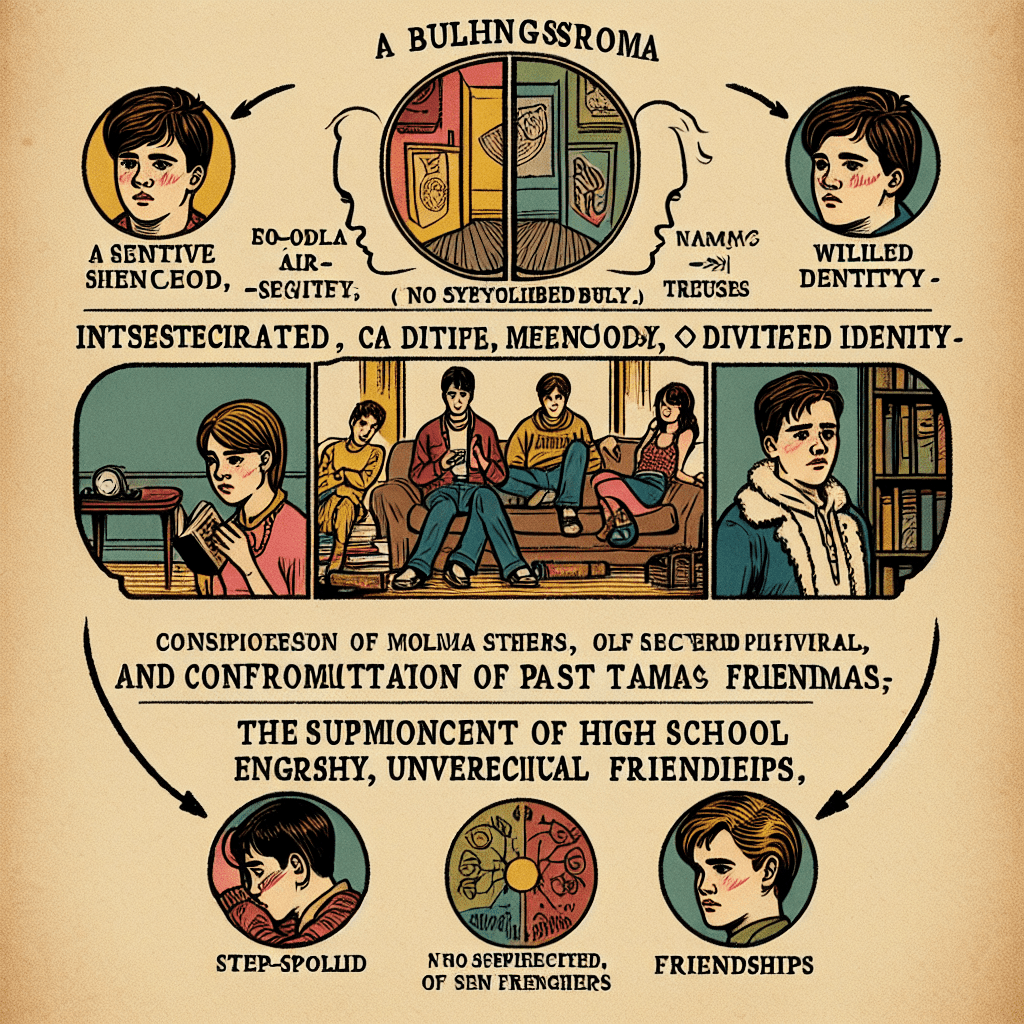-
Table des matières
- Résumé de The Perks of Being a Wallflower (Les avantages d'être une fleur bleue)
- Exploration des principaux thèmes du roman
- Analyse du personnage de Charlie
- Le rôle de l'amitié dans The Perks of Being a Wallflower
- L'impact de la santé mentale sur les personnages
- L'histoire du passage à l'âge adulte
- Q&R
"Découvrez le voyage de la découverte de soi, de l'amitié et des luttes de l'adolescence dans 'The Perks of Being a Wallflower'.
"The Perks of Being a Wallflower", écrit par Stephen Chbosky, est un roman sur le passage à l'âge adulte qui suit la vie de Charlie, un lycéen introverti de première année qui navigue dans les méandres de l'adolescence. À travers une série de lettres adressées à un ami anonyme, Charlie partage ses expériences en matière d'amitié, d'amour, de traumatisme et de découverte de soi. Le roman explore des thèmes tels que les problèmes de santé mentale, l'importance des liens et l'impact des expériences passées sur le développement personnel. Les personnages clés sont Charlie, ses amis Sam et Patrick, et sa famille, chacun contribuant à la riche tapisserie du voyage de Charlie vers la compréhension de lui-même et du monde qui l'entoure. La narration poignante du livre et ses thèmes pertinents trouvent un écho auprès des lecteurs, ce qui en fait une œuvre importante de la littérature contemporaine.
Résumé de The Perks of Being a Wallflower (Les avantages d'être une fleur bleue)
"The Perks of Being a Wallflower", un roman de Stephen Chbosky, se déroule à travers une série de lettres écrites par le protagoniste, Charlie, un lycéen de première année qui navigue dans les complexités de l'adolescence. Le récit commence par les réflexions de Charlie sur sa vie, marquée par la perte récente de son meilleur ami qui s'est suicidé. Cet événement lui donne un sentiment d'isolement et de vulnérabilité, alors qu'il est aux prises avec ses émotions et la difficulté de s'intégrer. À travers ses lettres, Charlie partage ses expériences, ses pensées et ses sentiments, offrant aux lecteurs un aperçu intime de sa psyché.
Au fil de l'histoire, Charlie se lie d'amitié avec deux personnes âgées, Patrick et sa demi-sœur Sam, qui lui font découvrir un monde d'amitié, d'amour et de découverte de soi. Leur dynamique devient un aspect essentiel du récit, car ils aident Charlie à sortir de sa coquille et à expérimenter les joies et les peines de la vie d'adolescent. Le trio s'engage dans diverses activités, allant de la participation à des fêtes à l'exploration des complexités des relations romantiques, qui servent à mettre en évidence les thèmes de l'acceptation et de l'appartenance. Le parcours de Charlie n'est pas sans heurts ; il est confronté à des questions telles que la santé mentale, les traumatismes et l'impact de la dynamique familiale sur sa perception de lui-même.
Tout au long du roman, les lettres de Charlie révèlent sa nature introspective et son désir de comprendre le monde qui l'entoure. Il réfléchit souvent à la signification des moments, soulignant l'importance d'être présent et de chérir les expériences. Ce thème de la pleine conscience résonne profondément, car Charlie apprend à apprécier la beauté des hauts et des bas de la vie. Ses relations avec Patrick et Sam jouent un rôle déterminant dans sa croissance, car ils l'encouragent à assumer son identité et à affronter son passé.
En outre, le roman aborde les complexités de l'amour et de l'amitié. L'engouement de Charlie pour Sam lui fait découvrir la nature douce-amère de l'amour non partagé, tandis que son lien avec Patrick montre l'importance de la loyauté et du soutien entre amis. Ces relations ne sont pas simplement superficielles ; elles poussent Charlie à affronter ses insécurités et ses peurs, ce qui le conduit finalement à une meilleure compréhension de lui-même et de sa place dans le monde.
Au fil du récit, la santé mentale de Charlie devient un élément central. Il connaît des moments d'anxiété et de dépression intenses, qui sont exacerbés par son passé traumatique. Le roman n'hésite pas à aborder ces questions, qu'il dépeint au contraire avec sensibilité et réalisme. Grâce à une thérapie et au soutien de ses amis, Charlie commence à démêler la complexité de ses émotions, illustrant ainsi l'importance de demander de l'aide et de favoriser des conversations ouvertes sur la santé mentale.
En conclusion, "The Perks of Being a Wallflower" est une exploration poignante des épreuves et des tribulations de l'adolescence. À travers les lettres de Charlie, les lecteurs sont invités à assister à son voyage de découverte de soi, marqué par les thèmes de l'amitié, de l'amour et de la lutte pour l'acceptation. La richesse du développement des personnages et la profondeur émotionnelle du roman trouvent un écho chez tous ceux qui se sont déjà sentis marginalisés, ce qui en fait un récit intemporel sur le passage à l'âge adulte. En fin de compte, les expériences de Charlie nous rappellent l'importance des liens et le pouvoir transformateur de la compréhension de soi et des autres.
Exploration des principaux thèmes du roman
"The Perks of Being a Wallflower", un roman poignant de Stephen Chbosky sur le passage à l'âge adulte, aborde une myriade de thèmes qui trouvent un écho profond chez les lecteurs, en particulier ceux qui naviguent dans le paysage tumultueux de l'adolescence. L'un des thèmes les plus importants est la lutte pour l'identité. Le protagoniste, Charlie, entreprend un voyage à la découverte de lui-même, aux prises avec ses traumatismes passés et la complexité de ses émotions. Alors qu'il navigue dans le lycée, il rencontre diverses influences qui façonnent sa compréhension de ce qu'il est et de ce qu'il aspire à devenir. Cette exploration de l'identité n'est pas seulement une quête personnelle ; elle reflète le défi universel auquel sont confrontés de nombreux adolescents qui cherchent à se définir au milieu des attentes de la société et des pressions exercées par leurs pairs.
Un autre thème important est celui de l'amitié et des liens. Tout au long du roman, Charlie noue des liens profonds avec ses amis, Sam et Patrick, qui lui font découvrir de nouvelles expériences et perspectives. Ces relations sont une bouée de sauvetage pour Charlie, lui procurant un sentiment d'appartenance dont il a désespérément besoin. Le roman illustre comment les amitiés peuvent être à la fois une source de joie et un catalyseur pour le développement personnel. Alors que Charlie apprend à naviguer dans la complexité de ces relations, il est également confronté à la douleur de la perte et de la trahison, ce qui met en évidence la double nature des liens humains. Ce thème souligne l'idée que si les amitiés peuvent nous élever, elles peuvent aussi nous pousser à affronter nos vulnérabilités.
De plus, le thème de la santé mentale est intimement lié au récit. Les luttes de Charlie contre la dépression et l'anxiété sont décrites avec sensibilité et réalisme, mettant en lumière le sujet souvent tabou de la maladie mentale. À travers les lettres de Charlie, les lecteurs découvrent ses combats intérieurs, exacerbés par ses expériences traumatisantes. Le roman souligne l'importance de demander de l'aide et l'impact des relations de soutien sur le bien-être mental. En abordant ouvertement la question de la santé mentale, Chbosky encourage les lecteurs à s'engager dans des conversations sur leurs propres difficultés, ce qui favorise un sentiment d'empathie et de compréhension.
En outre, le thème de l'amour - romantique et platonique - joue un rôle crucial dans l'histoire. L'engouement de Charlie pour Sam illustre les complexités de l'amour jeune, caractérisé par le désir, la confusion et la nature douce-amère des sentiments non réciproques. Cette exploration de l'amour va au-delà des intérêts romantiques, car Charlie apprend à apprécier l'amour et le soutien de ses amis et de sa famille. Le roman suggère que l'amour, sous ses nombreuses formes, est une force puissante qui peut inspirer la croissance et la guérison, même face à l'adversité.
En outre, le thème de la nostalgie est omniprésent dans le récit, car Charlie réfléchit à ses expériences et au temps qui passe. L'acte d'écrire des lettres lui permet de traiter ses souvenirs, à la fois joyeux et douloureux. Cette qualité réflexive invite les lecteurs à réfléchir à leurs propres expériences et à la manière dont elles façonnent leur identité. La nature douce-amère de la nostalgie est évidente lorsque Charlie est confronté à la nature éphémère de la jeunesse et à l'inévitabilité du changement.
En conclusion, "The Perks of Being a Wallflower" explore magistralement les thèmes de l'identité, de l'amitié, de la santé mentale, de l'amour et de la nostalgie, créant une riche tapisserie qui trouve un écho chez les lecteurs de tous âges. À travers le parcours de Charlie, Chbosky nous invite à réfléchir à nos propres expériences et aux liens qui façonnent nos vies, nous rappelant finalement la beauté et la complexité de l'expérience humaine.
Analyse du personnage de Charlie
Dans le roman de Stephen Chbosky "The Perks of Being a Wallflower", le protagoniste, Charlie, sert de lentille poignante à travers laquelle les lecteurs explorent les complexités de l'adolescence, de la santé mentale et de la quête d'identité. Adolescent introspectif et sensible, Charlie incarne les luttes de nombreux jeunes qui naviguent dans les eaux tumultueuses de la vie lycéenne. Son caractère est marqué par un sens profond de l'observation, qui lui permet de percevoir le monde qui l'entoure avec une profondeur qui échappe souvent à ses pairs. Cette qualité ne le distingue pas seulement des autres, elle le positionne aussi comme la quintessence de la "tapisserie", quelqu'un qui observe plutôt que de participer, reflétant un commentaire plus large sur la nature de la dynamique sociale pendant l'adolescence.
Le parcours de Charlie est fortement marqué par ses expériences de traumatisme et de perte. Le roman s'ouvre sur le récent suicide de son meilleur ami, Michael, un événement qui laisse une marque indélébile sur son psychisme. Cette perte catalyse les luttes émotionnelles de Charlie, l'amenant à faire face à des sentiments d'isolement et de confusion. Au cours de sa première année d'études, il est hanté par des souvenirs et des sentiments qu'il n'arrive pas à formuler, ce qui ajoute des couches à son caractère. Ses lettres, écrites à un ami anonyme, servent de dispositif narratif pour révéler ses pensées et ses sentiments les plus intimes, permettant aux lecteurs d'être témoins de ses vulnérabilités et de ses peurs. À travers ces lettres, le personnage de Charlie évolue, illustrant son désir de connexion et de compréhension dans un monde qui lui semble souvent aliénant.
En outre, les relations de Charlie avec les autres personnages jouent un rôle crucial dans son développement. Son amitié avec Patrick et Sam l'introduit dans un nouveau cercle social qui remet en question ses anciennes notions d'amitié et d'acceptation. Patrick, avec sa personnalité exubérante, et Sam, avec sa chaleur et sa gentillesse, deviennent des personnages clés dans la vie de Charlie, l'aidant à sortir de sa coquille. Leur influence l'encourage à vivre de nouvelles expériences, qu'il s'agisse d'assister à des fêtes ou d'explorer des sentiments romantiques. Cependant, ces relations exposent également Charlie aux complexités de l'amour, au chagrin d'amour et aux pressions de la conformité, ce qui complique encore son paysage émotionnel. En naviguant dans ces dynamiques, le personnage de Charlie reflète la lutte universelle pour trouver sa place dans un monde qui semble souvent écrasant.
Outre ses relations, l'introspection de Charlie l'amène à se confronter à des problèmes plus profonds liés à la santé mentale. Tout au long du roman, il est aux prises avec l'anxiété et la dépression, qui se manifestent de diverses manières, notamment par des crises de panique et un sentiment de détachement. Ses expériences soulignent l'importance de la sensibilisation à la santé mentale, en particulier chez les adolescents qui peuvent se sentir stigmatisés ou incompris. Le parcours de Charlie vers la guérison est graduel et semé d'embûches, mais il souligne l'importance de demander de l'aide et le pouvoir de la vulnérabilité. Le fait qu'il finisse par accepter ses problèmes de santé mentale témoigne de sa résilience et de l'importance de l'acceptation de soi.
En fin de compte, le personnage de Charlie incarne l'essence même de l'adolescence, marquée par la confusion, la croissance et la recherche d'un sentiment d'appartenance. À travers ses expériences, les lecteurs sont invités à réfléchir à leur propre parcours et à la myriade de facteurs qui façonnent leur identité. En apprenant à naviguer dans les méandres de l'amitié, de l'amour et de la perte, Charlie devient un personnage attachant et durable, qui nous rappelle la beauté et la douleur inhérentes au processus de croissance. Ainsi, "The Perks of Being a Wallflower" ne raconte pas seulement l'histoire de Charlie, mais résonne aussi avec tous ceux qui se sont déjà sentis étrangers dans leur propre vie.
Le rôle de l'amitié dans The Perks of Being a Wallflower
Dans le roman de Stephen Chbosky "The Perks of Being a Wallflower", le thème de l'amitié apparaît comme un élément central qui façonne le voyage du protagoniste à travers l'adolescence. Le récit, présenté à travers une série de lettres écrites par Charlie, un lycéen de première année sensible et introspectif, explore la complexité des relations humaines et l'impact profond qu'elles ont sur le développement personnel. Alors que Charlie navigue dans les eaux tumultueuses de la vie adolescente, les amitiés qu'il noue deviennent à la fois une source de réconfort et un catalyseur pour la découverte de soi.
Au début, Charlie est confronté à des sentiments d'isolement et d'aliénation, dus au traumatisme de la perte de son meilleur ami par suicide et à la difficulté de s'intégrer dans un nouvel environnement social. Cependant, sa vie prend un tournant transformateur lorsqu'il se lie d'amitié avec ses demi-frères Patrick et Sam, qui lui font découvrir un monde rempli d'acceptation, de joie et d'expériences exaltantes de la jeunesse. Grâce à ces amitiés, Charlie apprend l'importance de la vulnérabilité et la force qui découle de l'ouverture aux autres. Patrick, avec sa personnalité charismatique et extravertie, sert de guide, encourageant Charlie à s'épanouir et à sortir de sa zone de confort. Cette dynamique illustre la façon dont les amitiés peuvent fournir un espace sûr aux individus pour explorer leurs identités et affronter leurs peurs.
En outre, le roman explore les complexités de l'amitié, en soulignant ses aspects positifs et négatifs. Au fur et à mesure que Charlie s'intègre dans le cercle de Patrick et Sam, il connaît les joies de la camaraderie, comme les rires partagés, les conversations nocturnes et le frisson du premier amour. Cependant, le récit aborde également le côté sombre des amitiés, notamment la jalousie, les chagrins d'amour et les conflits inévitables qui surviennent à mesure que les individus grandissent et changent. Par exemple, les sentiments de Charlie pour Sam compliquent leur amitié, entraînant des moments de tension et de confusion. Cette exploration des multiples facettes de l'amitié souligne l'idée que les relations ne sont pas toujours simples ; elles exigent des efforts, de la compréhension et, parfois, des sacrifices.
En outre, le rôle de l'amitié dans "The Perks of Being a Wallflower" va au-delà de la simple compagnie ; elle sert de vecteur de guérison et d'épanouissement personnel. Tout au long de l'histoire, Charlie est aux prises avec sa santé mentale, confronté aux ombres de son passé et aux cicatrices émotionnelles qui persistent. Ses amis jouent un rôle crucial dans ce processus, lui apportant soutien et encouragement dans ses difficultés. L'amour inconditionnel et l'acceptation qu'il reçoit de Patrick et de Sam lui permettent d'affronter ses démons, ce qui le conduit finalement à une meilleure compréhension de lui-même et de sa place dans le monde. Ce thème trouve un écho chez les lecteurs, soulignant l'idée que les vrais amis peuvent aider à éclairer le chemin de la guérison et de l'acceptation de soi.
En conclusion, le rôle de l'amitié dans "The Perks of Being a Wallflower" fait partie intégrante du récit, servant à la fois de source de joie et de moyen de développement personnel pour Charlie. Grâce à ses relations avec Patrick et Sam, il apprend de précieuses leçons sur la vulnérabilité, l'acceptation et la complexité des liens humains. Ce roman illustre de manière poignante que si les amitiés peuvent être semées d'embûches, elles ont aussi le pouvoir de guérir et de transformer, pour finalement façonner les individus que nous devenons. En accompagnant Charlie, les lecteurs se rendent compte de l'impact profond que les amitiés peuvent avoir sur nos vies, en particulier pendant les années formatrices de l'adolescence.
L'impact de la santé mentale sur les personnages
Dans "The Perks of Being a Wallflower", Stephen Chbosky tisse de manière complexe le thème de la santé mentale dans la vie de ses personnages, illustrant comment leurs luttes façonnent leurs identités et leurs relations. Le protagoniste, Charlie, sert de lentille poignante à travers laquelle les lecteurs peuvent explorer les complexités de la santé mentale. Adolescent sensible et introspectif, Charlie est aux prises avec les séquelles d'un traumatisme, qui se manifestent par des expériences de dépression et d'anxiété. Son parcours au lycée est marqué par un profond sentiment d'isolement, un sentiment qui trouve un écho chez de nombreux adolescents qui se retrouvent à naviguer dans les eaux tumultueuses de l'adolescence.
Les problèmes de santé mentale de Charlie sont aggravés par la perte de son meilleur ami, Michael, qui s'est suicidé. Cet événement laisse une marque indélébile sur Charlie, l'amenant à s'interroger sur sa propre valeur et sur la nature de l'amitié. Le récit révèle comment le deuil peut profondément affecter l'état mental d'une personne, entraînant souvent des sentiments de culpabilité et de confusion. Alors que Charlie tente de surmonter ses émotions, il se replie de plus en plus sur lui-même, illustrant la façon dont les problèmes de santé mentale peuvent créer des obstacles à l'interaction sociale et à l'expression de soi. Cet isolement est encore exacerbé par son incapacité à exprimer ses sentiments, un défi courant pour les personnes souffrant de problèmes de santé mentale.
En outre, les personnages qui entourent Charlie reflètent également divers aspects de la santé mentale. Par exemple, son ami Patrick est aux prises avec ses propres difficultés, notamment la complexité de son identité sexuelle et les troubles émotionnels qui l'accompagnent. La personnalité vibrante de Patrick masque souvent ses luttes internes, soulignant le thème selon lequel les individus peuvent présenter une façade au monde tout en dissimulant leurs véritables sentiments. Cette dualité est un aspect essentiel de la santé mentale, car elle souligne l'importance de comprendre que les apparences extérieures ne reflètent pas toujours les réalités intérieures.
En outre, Sam, un autre personnage clé, incarne le thème de la guérison et de la résilience. Sa relation avec Charlie sert de catalyseur à sa croissance, démontrant ainsi que les amitiés de soutien peuvent jouer un rôle crucial dans le rétablissement de la santé mentale. Grâce à leur lien, Charlie commence à affronter ses traumatismes passés, ce qui illustre le pouvoir thérapeutique de la connexion et de la compréhension. Le personnage de Sam souligne également l'importance de l'acceptation de soi et du voyage vers le bien-être émotionnel, alors qu'elle navigue entre ses propres insécurités et aspirations.
Le roman aborde également la question de la stigmatisation de la santé mentale, notamment à travers les expériences thérapeutiques de Charlie. Ses séances avec son thérapeute lui offrent un espace sûr pour explorer ses sentiments et affronter son passé, soulignant l'importance de demander de l'aide. Cette représentation sert à normaliser la conversation autour de la santé mentale, en encourageant les lecteurs à reconnaître la valeur du soutien professionnel pour surmonter les difficultés personnelles.
En conclusion, "The Perks of Being a Wallflower" offre une exploration profonde de la santé mentale à travers ses personnages richement développés. En plongeant dans les méandres des expériences de Charlie, de Patrick et de Sam, Chbosky met en lumière les multiples facettes des problèmes de santé mentale et l'importance de l'empathie et de la compréhension. Le récit transmet finalement un message d'espoir, illustrant le fait que si les problèmes de santé mentale peuvent être décourageants, le voyage vers la guérison est possible grâce à la connexion, au soutien et à la découverte de soi. Dans cette optique, les lecteurs sont invités à réfléchir à leurs propres expériences et à l'importance de la santé mentale dans leur vie et celle de leur entourage.
L'histoire du passage à l'âge adulte
"The Perks of Being a Wallflower", un roman de Stephen Chbosky, tisse de manière complexe le parcours de passage à l'âge adulte de son protagoniste, Charlie, dans une riche tapisserie d'expériences émotionnelles et de croissance personnelle. Avec pour toile de fond le début des années 1990, le récit se déroule à travers une série de lettres écrites par Charlie à un ami anonyme, ce qui permet aux lecteurs de plonger profondément dans ses pensées et ses sentiments. Ce format épistolaire offre non seulement un aperçu intime de la psyché de Charlie, mais sert également de véhicule pour explorer les complexités de l'adolescence, de l'identité et de la quête d'appartenance.
Au fur et à mesure que l'histoire progresse, Charlie navigue dans les eaux tumultueuses du lycée, où il est confronté aux défis de l'amitié, de l'amour et de la perte. Ses premières luttes contre l'anxiété sociale et son sentiment d'isolement sont palpables, reflétant l'expérience universelle de nombreux adolescents qui se sentent exclus. Cependant, c'est grâce à ses relations avec ses nouveaux amis, Sam et Patrick, que Charlie commence à sortir de sa coquille. Leur acceptation et leurs encouragements jouent un rôle essentiel dans sa transformation, illustrant l'impact profond que l'amitié peut avoir pendant les années de formation. Cette dynamique met en lumière un thème central du roman : l'importance des liens pour surmonter les difficultés personnelles.
De plus, le parcours de Charlie est marqué par des moments de découverte de soi qui trouvent un écho chez les lecteurs. Au fur et à mesure qu'il s'implique dans la vie de Sam et de Patrick, il apprend à accepter ses émotions et à faire face à ses traumatismes passés. L'exploration de ses sentiments pour Sam, en particulier, sert de catalyseur à sa croissance. Grâce à ces expériences, Charlie commence à comprendre les complexités de l'amour et la nature douce-amère des relations. Ce thème de l'amour, à la fois romantique et platonique, souligne l'idée que le passage à l'âge adulte ne consiste pas seulement à vieillir, mais aussi à développer une compréhension plus profonde de soi-même et des autres.
Outre l'amitié et l'amour, le roman aborde le thème de la santé mentale, qui est intimement lié au passage à l'âge adulte de Charlie. Ses luttes contre la dépression et les effets persistants des traumatismes de l'enfance sont dépeints avec sensibilité et réalisme. En affrontant ces problèmes, Charlie apprend l'importance de demander de l'aide et la valeur de la vulnérabilité. Cet aspect de l'histoire n'ajoute pas seulement de la profondeur au personnage de Charlie, mais sert également de rappel poignant des défis auxquels de nombreux jeunes sont confrontés dans leur cheminement vers l'âge adulte. En abordant ouvertement la question de la santé mentale, Chbosky encourage les lecteurs à s'engager dans des conversations sur ces questions cruciales, favorisant ainsi un sentiment d'empathie et de compréhension.
En outre, le roman capture l'essence de l'adolescence à travers son exploration de l'identité. Le parcours de Charlie ne consiste pas seulement à surmonter des obstacles, mais aussi à découvrir qui il est au milieu des attentes de la société et de la pression exercée par ses pairs. En naviguant dans la complexité de ses relations et en affrontant ses peurs, il commence à se forger sa propre identité et finit par embrasser son caractère unique. Ce thème trouve un écho chez les lecteurs, car il reflète la lutte universelle pour trouver sa place dans le monde.
En conclusion, "The Perks of Being a Wallflower" résume magistralement le passage à l'âge adulte à travers les expériences, les relations et le développement personnel de Charlie. L'exploration de l'amitié, de l'amour, de la santé mentale et de l'identité dans ce roman crée un récit riche qui parle au cœur de l'adolescence. En accompagnant Charlie sur le chemin de la découverte de soi, les lecteurs se voient rappeler le pouvoir de transformation des liens et l'importance d'embrasser sa propre personnalité. Grâce à sa narration poignante, ce roman continue de trouver un écho auprès du public, ce qui en fait une exploration intemporelle des complexités du passage à l'âge adulte.
Q&R
1. **Quel est le postulat principal de "The Perks of Being a Wallflower" ?
Le roman suit Charlie, un lycéen de première année socialement maladroit, alors qu'il navigue entre les défis de l'adolescence, de l'amitié, de l'amour et de la santé mentale à travers une série de lettres adressées à un ami anonyme.
2. **Quels sont les thèmes clés du livre ?
Les principaux thèmes abordés sont les difficultés liées à la croissance, l'importance de l'amitié, l'impact des traumatismes, la sensibilisation à la santé mentale et la recherche d'une identité.
3. **Qui sont les personnages principaux de l'histoire ?
Les personnages principaux sont Charlie, le protagoniste introspectif, Sam, son intérêt amoureux et un élève de terminale à l'esprit libre, Patrick, le demi-frère de Sam et l'ami proche de Charlie, et la famille de Charlie, qui joue un rôle important dans son développement émotionnel.
4. **Comment la santé mentale de Charlie affecte-t-elle ses expériences ?
Les luttes de Charlie contre la dépression et l'anxiété façonnent ses interactions et ses relations, influençant sa perception des événements et sa capacité à entrer en contact avec les autres.
5. **Quel rôle joue l'amitié dans la vie de Charlie ?
L'amitié est cruciale pour la croissance de Charlie ; elle lui apporte soutien, acceptation et un sentiment d'appartenance, l'aidant à affronter son passé et à développer son identité.
6. **Quelle est la signification du titre "The Perks of Being a Wallflower" ?
Le titre reflète l'idée d'être un observateur dans la vie, en soulignant les avantages d'être une tapisserie, comme le fait de mieux comprendre la vie des autres, tout en abordant la solitude et l'isolement qui peuvent l'accompagner. "The Perks of Being a Wallflower" explore les complexités de l'adolescence à travers les yeux de Charlie, un adolescent sensible et introspectif qui navigue entre les défis du lycée, de l'amitié et de la santé mentale. Les thèmes principaux sont les luttes d'identité, l'impact des traumatismes, l'importance des liens et le cheminement vers l'acceptation de soi. Les personnages, dont Charlie, ses amis Sam et Patrick, et d'autres encore, représentent chacun différentes facettes de la vie d'un adolescent, soulignant l'importance du soutien et de la compréhension pour surmonter les difficultés personnelles. En fin de compte, le roman souligne l'importance d'accepter ses expériences et le pouvoir transformateur de l'amour et de l'amitié dans le processus de croissance.




